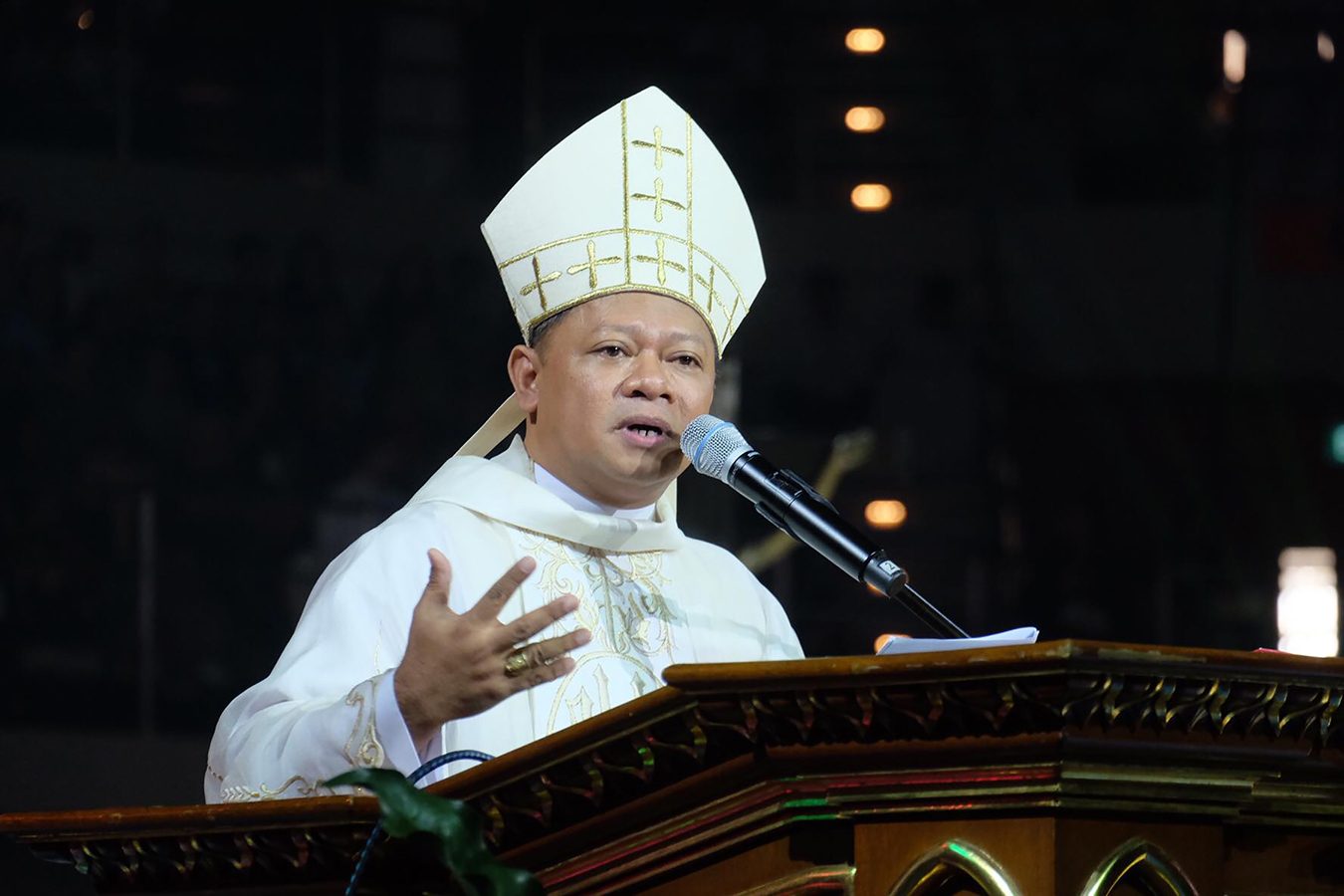SUMMARY
This is AI generated summarization, which may have errors. For context, always refer to the full article.

MANILA, Philippines – From nearby Camarines Norte where he is the outgoing prelate, Bishop Rex Andrew Alarcon is moving to the center of Catholic devotion of his home region Bicol.
Pope Francis named Alarcon on Thursday, February 22, as the new archbishop of the Archdiocese of Caceres, a Catholic territory that covers three districts in the province of Camarines Sur. While he heads the Catholic Church only in these districts, the archbishop of Caceres is considered the “first among equals” among the seven bishops of Bicol.
Alarcon replaces Rolando Octavus Tria Tirona, a native of Sampaloc, Manila, who served as Caceres archbishop from 2012 until his retirement this year at the age of 77.
“Salamat sa Diós! Viva la Virgen! (Thanks be to God! Long live the Virgin!)” announced the Archdiocese of Caceres in a post on its Facebook page shortly after the Vatican made the appointment public at 7 pm (Manila time) on Thursday.
Born in Daet, Camarines Norte, the 53-year-old Alarcon was the Philippines’ youngest bishop when he was ordained in 2019. He currently chairs the Episcopal Commission on Youth of the Catholic Bishops’ Conference of the Philippines (CBCP).
He finished high school and philosophy courses at the Holy Rosary Minor Seminary in Naga, studied theology at the University of Santo Tomas in Manila, and later obtained a licentiate in church history at the Pontifical Gregorian University in Rome.
Alarcon’s appointment is made more significant by the fact that Bicol – known for its deep and widespread devotion to Our Lady of Peñafrancia – is the Philippine region with the highest percentage of Catholics.
Bicol’s Catholic population, according to the 2020 Census of Population and Housing, stands at 5.67 million or 93.5% of total residents. Bicol is followed only by Eastern Visayas at 92.3% and Calabarzon at 89.2%.
Throughout the Philippines, the percentage of Catholics is 78.8% – making Bicol an ecclesiastical powerhouse in this predominantly Catholic country.
Catholic devotion in Bicol comes in full force every third Saturday of September when they celebrate the Feast of Our Lady of Peñafrancia, a 313-year-old image that devotees believe to be miraculous.
The patroness of Bicol is housed in the Basilica Minore and National Shrine of Our Lady of Peñafrancia in Naga.

Wherever they are found in the world, Bicolanos affectionately call Our Lady of Peñafrancia their “Ina” – their mother. Among the public figures who pray to Our Lady of Peñafrancia fiesta is former vice president Leni Robredo, who hails from Naga. Former senator Leila de Lima, who was born in Iriga, Camarines Sur, is also among the Bicolanos devoted to “Ina.”
Why Alarcon is ‘first among equals’
The Archdiocese of Caceres, one of the country’s oldest dioceses, holds a place of honor in church history in the Philippines.
The archdiocese follows the old name of Naga City, Camarines Sur – “Nueva Caceres” – which, in turn, was named after a Spanish city in 1595. The archdiocese was founded that same year, less than two decades after the Philippines’ first diocese – Manila – was established in 1579.
As Caceres archbishop, Alarcon will preside over the Ecclesiastical Province of Caceres, which covers the six civil provinces of Bicol: Albay, Camarines Norte, Camarines Sur, Catanduanes, Masbate, and Sorsogon.
These provinces correspond to seven Catholic dioceses: the Archdiocese of Caceres (covering Districts III, IV, and V of Camarines Sur), the Diocese of Daet (covering Camarines Norte), the Diocese of Libmanan (covering Districts I and II, and Gainza town of District III, in Camarines Sur), the Diocese of Legazpi (covering Albay), the Diocese of Sorsogon (covering Sorsogon), the Diocese of Virac (covering Catanduanes), and the Diocese of Masbate (covering Masbate).
According to Canon 436 of the Code of Canon Law, a metropolitan – that is, an archbishop who presides over an ecclesiastical province – can provide oversight of the “suffragan” dioceses entrusted to him.
The metropolitan is allowed, for instance, “to exercise vigilance so that the faith and ecclesiastical discipline are observed carefully and to inform the Roman Pontiff of abuses, if there are any” in the suffragan dioceses. In Alarcon’s case, these are the dioceses of Daet, Libmanan, Legazpi, Sorsogon, Virac, and Masbate.
“The metropolitan has no other power of governance in the suffragan dioceses. He can perform sacred functions, however, as if he were a bishop in his own diocese in all churches, but he is first to inform the diocesan bishop if the church is the cathedral,” the Code of Canon Law states.
The metropolitan “also meets with the suffragan bishops to discuss matters of importance to the region,” CBCP News explained.
Poverty and natural calamities are among the perennial problems and points for discussion among church leaders in Bicol. – Rappler.com
Add a comment
How does this make you feel?



![[WATCH] Rappler Live Jam: dwta](https://www.rappler.com/tachyon/2024/07/live-jam-1280-baba.jpg?resize=257%2C257&crop=179px%2C0px%2C1080px%2C1080px)


![[The Wide Shot] Peace be with China](https://www.rappler.com/tachyon/2024/07/wideshot-wps-catholic-church.jpg?resize=257%2C257&crop=311px%2C0px%2C720px%2C720px)
![[OPINION] A critique of the CBCP pastoral statement on divorce](https://www.rappler.com/tachyon/2024/07/TL-cbcp-divorce-statement-july-19-2024.jpg?resize=257%2C257&crop=285px%2C0px%2C722px%2C720px)
![[REFLECTION] Mary, Mother of the West Philippine Sea](https://www.rappler.com/tachyon/2024/07/may-mother-west-ph-sea-july-19-2024.jpg?resize=257%2C257&crop=293px%2C0px%2C751px%2C750px)
![[OPINION] Ignorance and prejudice](https://www.rappler.com/tachyon/2024/07/tl-ignorance-and-prejujdice.jpg?resize=257%2C257&crop_strategy=attention)
There are no comments yet. Add your comment to start the conversation.